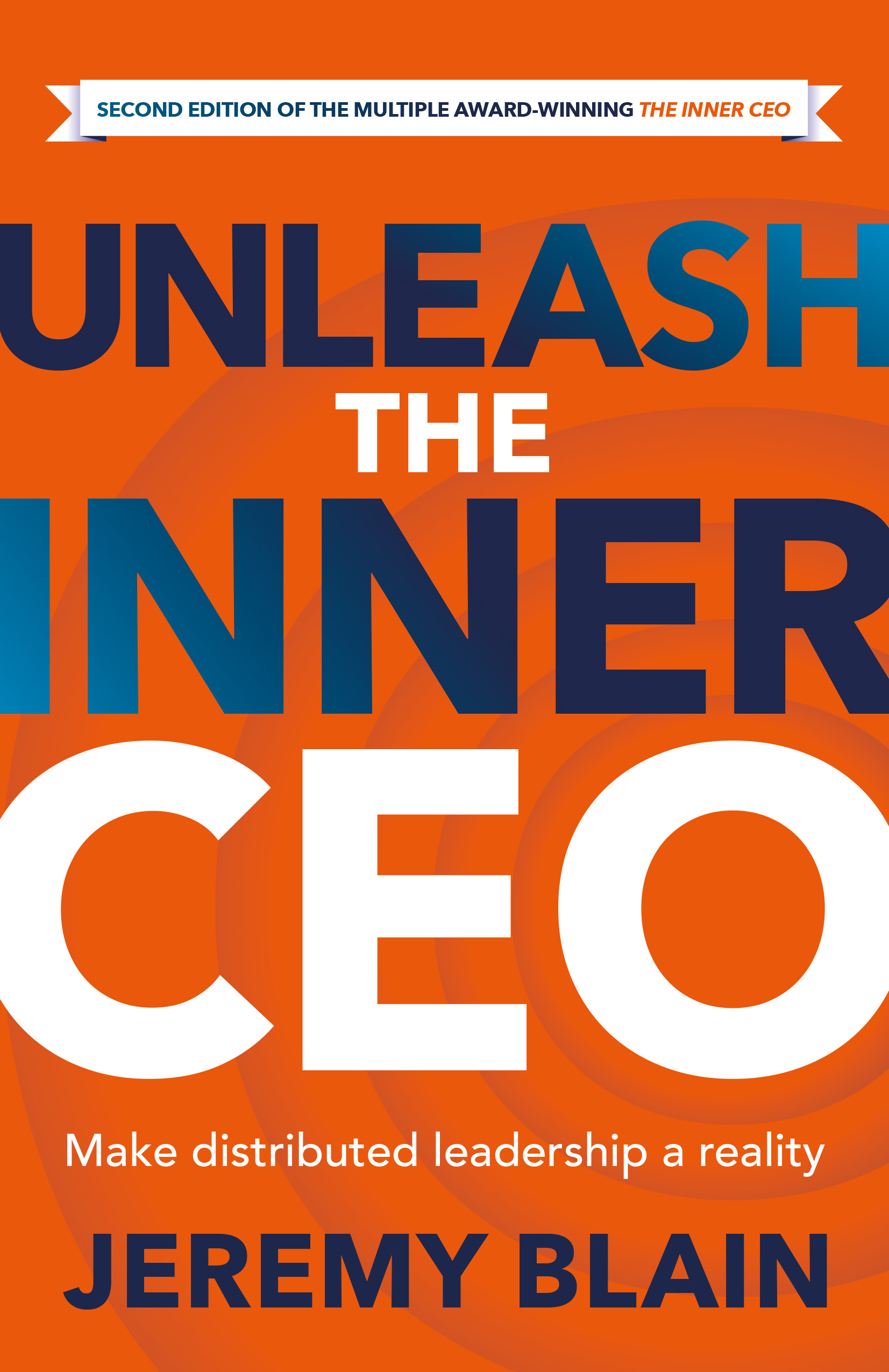Everyone has a side of them where they like to take control and see their dreams come true. Some take it to the next level; others just accept what is. Jeremy Blain is taking a renewed look at what leadership can do and going beyond the notion of individual empowerment to embrace the need to shift entire cultures to not only allow for distributed leadership but also nurture it.
This book offers inspiration to how to create an organizational culture of experimentation, boldness and trust providing the tools to unleash their inner CEO and become an “in-role CEO”: someone empowered to lead with creativity, innovation and purpose. Even if you don’t believe you could be a CEO, I push you to read this book and really explore your possibilities.
As Blain explains, the underlying principle is to harness the leadership potential that exists at all levels to tackle the complex strategic and operational challenges facing most businesses today. It’s not only about the top of the company but also empowering individual contributors – regardless of level, function, experience or role – to contribute inside or outside of their core job description, both operationally and strategically. It’s no longer – “it’s not in my job description” but it goes well beyond that.
In today’s world, with all the technology and Ai, we can now look forward to almost limitless possibilities as the pace of digital innovation accelerates. Blain also warns that you must know how to regulate it, utilize it and manage it, retaining a deeply human touch. That is the magic of digital: to enable humans. You see, technology is not there to replace humans but there to help them achieve what they never thought possible.
Corporations that are unable, or unwilling, to adapt to the new waves of innovation coming their way are marked for certain failure. Today, leaders must adjust, realign and build a new mentality and approach to digital business model transformation and human-centered leadership in their organizations.
As with any new progress leap or technology, we have to be aware of the risks and narratives associated with innovations and have the ability to select and apply the appropriate technology to fit the purpose and use it to enable a high-touch way forward, enabling those accompanying them on the journey to collaborate, share and communicate effectively and efficiently.
Blain’s research found a lack of understanding at senior levels in the organization to be the biggest blocker of progress in this area. Almost half of all leaders surveyed did not have a vision for the digital era, and 40% of those had no intention of developing one. You know the phrase, I’m old school, I like things the way they were and I will continue to run the company that way. What is happening now is that those companies, for the most part, are no longer succeeding but they are falling behind those that are accepting technology and applying it within their organizations.
When we put digital transformation together with the workforce and human shifts, we must consider a culture-building strategy where leaders need to be more humanity-centered and purpose-driven and value people in different ways, balanced with the need to make money.
Blain states that it’s not about looking outside of the organization to get the talent but this is about utilizing the talent within the organization where it is best placed, without being limited by a formal job description. This is extremely freeing and empowering for both management and the workforce.
Blain explains the Five-Point Star model which facilitates a collaborative discussion with any individual, at any level in the organization, with their line manager, functional leader or HR business partner.
The Five-Point Star Model consists of:
Attitude – Culture – Leadership – Interpersonal Skill – Performance
Blain believes that as we move toward the 2030s, horizontal management is a rapidly growing trend. Also known as “flat” management, it emphasizes an organization’s structure with fewer middle managerial layers, fostering a more inclusive, adaptable and team-oriented environment. This approach seeks to enhance efficiency and communication and to empower everyone in the organization.
Unleashing the inner CEO is about people moving from being almost entirely operational, driven by their job description and KPIs, to becoming more strategic. Companies are also seeking advisers that have a proven track record of advising leaders in the new corporate era, rather than relying on traditional, twentieth-century legacy thinking and ways of operating.
Then the thinking must be about how to recognize and reward new behaviors, emerging skills and those making an impact beyond their role as they contribute to broader business health. Where HR professionals and managers are empowering individual contributors and providing the foundation for greater personal autonomy, authority and action for leaders at all levels.
The successful employee of the future must also take calculated risks, with the support of management, because this is going to be increasingly important.
Blain not only advises on the process but provides tools such as the 90-Day Road Map which is designed to be modified to suit various organizational and personal needs and incorporates the main activities and expected outputs for in-role CEOs as they embrace the concept and then the reality of distributed leadership.
The Road Map also lists some of the early warning signs to look for and the corrective actions that will keep the implementation on track, improving and refining as you go, consistently across the organization.
When taking on new projects and operating with greater autonomy, it will be necessary for in-role CEOs to handle situations and pressures that they may not have had to deal with in the old hierarchy.
Blain sums it up with everyone needing to be accountable and responsible for growth, both theirs and that of the organization. Engaged, mobilized and motivated people are central to creating this ideal environment, which links to satisfaction in a job role, attracts talent into the business and helps to retain great people. Attraction and retention take care of themselves in this context, whether that’s with a permanent workforce or an increasingly loyal independent workforce of people who want to work for you and with you.
Published by Rethink Press
Reviewed by Monique Vander Eyken, HR Consultant – MVE Consulting







